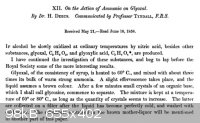| Pages:
1
..
4
5
6 |
VladimirLem
Hazard to Others
  
Posts: 204
Registered: 24-5-2010
Member Is Offline
Mood: Have no fear <Vlad> is here.
|
|
| Quote: |
wtf?
u're getting stroppy cause the steel-target havent got more damage?
how about putting the ignitor ONTOP of the charge (like a shaped charge) to force the detonation to move towards the steelplate and not to the side of
the charge? 
[Edited on 15-3-2013 by VladimirLem] |
|
|
|
SherlockHolmes
Harmless

Posts: 44
Registered: 29-7-2012
Location: Bulgaria
Member Is Offline
Mood: No Mood
|
|
Exactly detonator had to do but I knew until after the test 
Sorry for my english. I am not from England. Thank you!
|
|
|
Ral123
National Hazard
   
Posts: 735
Registered: 31-12-2011
Member Is Offline
Mood: No Mood
|
|
I had s cup of water/ammonia with MN on the bottom for storage. It appears the MN dissolves in the water and evaporates from the top, even trough the
layer is on the bottom. After a week there's no MN in the cup, only water. Is it possible that some other process has taken place?
|
|
|
WGTR
National Hazard
   
Posts: 971
Registered: 29-9-2013
Location: Online
Member Is Offline
Mood: Outline
|
|
This looks like the generic methyl/ethyl nitrate thread, so I think this is the right place to post this.
I have an issue that might seem unusual. I'm trying to not make ethyl nitrate. I'm actually interested in making glyoxal
(to synthesize ionic liquids), and am trying to avoid performing any unintentional nitrations. This is basically a sanity check of sorts, to make
sure that I'm not doing something stupid. I have little experience reacting nitric acid with organics, so I'm approaching this with caution.
Debus originally made glyoxal by oxidizing ethyl alcohol slowly with nitric acid at "ordinary temperatures".

Philosophical Transactions of the Royal Society of London, Volume 148
Generally they would do this by carefully pouring the alcohol on top of the acid, so that two layers would form without mixing. The reaction would
gradually occur by diffusion of the two layers.
My old friend Debus was a very smart guy, but he lived during a time when people pipetted chemicals with their mouths, and tasted unknown substances
to identify them. I hope he will forgive me for not trusting his procedures 100%.
A newer patent is a bit more descriptive, but starts directly from acetaldehyde:
Attachment: US3429929.pdf (224kB)
This file has been downloaded 604 times
I intend to use the methods from the patent, but rather start from ethyl alcohol instead, to attempt performing a one-pot reaction.
Basically, the plan is to react 0.5% copper(II) oxide (catalyst) with 50% nitric acid solution. A small amount of sodium nitrite (initiates
reaction) will be added to absolute alcohol, and then the nitric acid will be slowly added under stirring to the alcohol (maybe over 1-2 hours). The
temperature will be maintained at 40°C with a water/ice bath. Naturally, this will have to be done on reflux to keep the acetaldehyde from
escaping.
Note that I'm forming nitrous acid in situ, that there is water in the reaction (50% nitric acid), and that the acid is being added slowly to keep the
temperature at 40°C.
Am I properly avoiding the conditions that would perform a nitration?
|
|
|
| Pages:
1
..
4
5
6 |